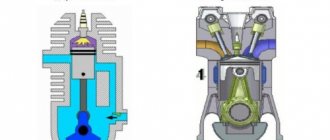How do they switch from semi-synthetics to synthetics and when do they do it? Many car owners are interested in whether it is possible to pour synthetic oil after using semi-synthetics.
Some believe that changing oil products does not pose any danger to the internal combustion engine. However, not all so simple.
All modern lubricants for cars are divided into:
- mineral;
- synthetic;
- semi-synthetic.
Mineral water is inexpensive and is usually poured into cars that were produced a long time ago. Semi-synthetics have an average cost and are optimal for most cars.
Synthetics are more expensive than other lubricants, but have high technical characteristics.
When is it necessary to change the oil type?
Types of oils
You have to switch from semi-synthetic oil to synthetic or vice versa for various reasons. For example, if you have been using your car for a long time and have a high mileage on the odometer, it is better to fill it with semi-synthetics instead of synthetics. Also, sometimes the oil previously poured into the engine disappears from sale. In the latter case, you may only have to change the brand of engine oil, and the type of lubricant itself will not change. We recommend reading the article about the types of motor oils.
Sometimes the question of switching to another oil arises among people who bought a used car. We do not recommend trusting the seller’s words regarding previously filled oil; it is better to simply fill in a new, guaranteed suitable oil, following the rules for switching from one fluid to another.
Flushing the engine when switching to another oil
When replacing mineral oil with semi-synthetic oil, auto mechanics usually recommend flushing the engine. This operation is performed in two ways:
- use of a flushing additive;
- pouring special flushing oil.
Oil change kit with flush
We do not recommend using either of these washes. The fact is that they contain aggressive detergent additives, and after draining the liquid, about 10% of the filled liquid remains in the engine cavities. When you fill the system with new oil, it will mix with aggressive flushing, and this can harm the engine.
Each oil contains certain additives, the list of which is not disclosed by manufacturers - this is a trade secret. When mixing different lubricant compositions, especially when adding additives of different types, the compositions can interact, causing negative chemical reactions and the formation of new substances. Sometimes insoluble compounds even form and a precipitate forms, which has a bad effect on the service life.
It should be noted that car engine manufacturers do not mention in their instructions that the engine needs to be flushed when changing the fluid. In addition, well-known companies do not even produce special flushing fluids.
How to change mineral oil to synthetic oil and vice versa?
How to change mineral oil to synthetic oil and vice versa?
Spring is the traditional season for car maintenance, and many car enthusiasts want to pamper their “pet” with at least good oil.
And here many questions arise: is it necessary to flush the oil system, is it possible to mix oils, etc. We will try to answer the most relevant ones.
Does the oil system need to be flushed?
The purpose of flushing the oil system is to remove deposits and wear products from the internal surface of the engine. The cleaner the engine, the less need for this procedure. While the car is new, it is enough to use high-quality oils and change them on time . Its owner should have an idea about the cleanliness of used engine parts by observing the partial disassembly of the engine for scheduled adjustments, or based on the recommendations of a service station technician.
If you purchase a used car, it is better to immediately replace all technical fluids, making sure to flush the oil system. Wash the engine with special flushing oil, the additives of which dissolve well and wash away various deposits.
When switching from mineral oil to synthetic or semi-synthetic oil, the engine does not need to be flushed, unless, of course, the prerequisites listed above exist. If, on the contrary, you decide to save a little and temporarily switch to mineral water, there is no need to flush the engine.
Are synthetics suitable for all engines?
The answer to the above question is best found in your instruction manual. It lists recommended oils that meet certain requirements and characteristics. It happens that seemingly expensive and good oil, filled out of the owner’s desire to do “the best,” leads to annoying troubles.
All rubber seals that are not designed for certain additives present in the oil may leak. It can be worse when individual alloys present in the design of a given engine react. This behavior is more typical for old engines using outdated technologies (for example, VAZ), but it is better not to experiment.
In other cases, switching to higher quality oil is always good for the engine. Another thing is that it may not be economically feasible. For example, if the rings are already worn out, the use of synthetics can increase oil consumption due to waste, and overall costs will increase several times. As they say, “not the horse’s feed.”
If you bring the engine to normal condition, then the use of synthetics or semi-synthetics will only increase the life of the engine.
Is it permissible to mix oils?
Unfortunately, oil manufacturers do not recommend mixing their synthetic and semi-synthetic oils with others, but mineral varieties should interact normally with each other. So if your engine “eats up” oil, this is another reason not to rush to switch to semi-synthetics until this problem is solved.
To top up synthetic varieties, you can use oils of a different brand, but you need to choose an oil in the same category as the one you are using. For example, API SG/CD synthetics can be mixed with oil from another manufacturer, but of the same API SG/CD category. At the same time, it is unknown how the additive packages used differ, so mileage on such a mixture should be reduced as much as possible.
Is it possible to increase the mileage between maintenance after switching to synthetics?
Synthetic oil does not oxidize as quickly as mineral oil, and therefore can last longer. On the other hand, the degree of its oxidation largely depends on the fuel used, its sulfur content, etc. Even at gas stations they don’t really know about the actual composition of the fuel.
So it is possible to increase the mileage between maintenance, but not as advertised at the car dealership. Motorists recommend changing semi-synthetic and synthetic oil in our conditions with a mileage of up to 12 thousand km (or after a year of operation), despite the permissible mileage from the manufacturer of 15 thousand km .
Based on materials from: https://ukrautoportal.com/news
How to switch to another oil?
When you plan to switch from synthetics to semi-synthetics or change other oils, you can do everything very simply. We fill in new fluid and drive it for a while (a few hundred kilometers are enough). We drain this lubricant and fill the system with the same fresh oil. In this case, you are guaranteed to avoid a negative effect.
Some motorists will find this costly, since high-quality oil is not cheap. Despite this, everyone chooses for themselves whether it is worth saving on it. Undoubtedly, the service life of a car engine inevitably decreases when unsuitable oils of dubious origin are poured into it.
general information
Inexperienced motorists who live in the Russian Federation believe that the use of licensed and high-quality oils is absolutely safe for the engine and is not capable of causing problems.
The transition from semi-synthetics to synthetics is often carried out by car owners, but it must be done correctly.
Determining oil quality by shade
When purchasing a car, you need to make sure which car oil is optimal for pouring into it. This is of great importance because oil fluid is the second most important consumable after fuel. The car will not drive without oil, so you need to choose it as carefully as you choose fuel.
Only after a thorough clarification of the technical characteristics of the lubricant and the selection of a suitable consumable can you begin the replacement procedure. It is simple enough even for an inexperienced motorist.
However, today every driver has the opportunity to contact a specialized service center. Its employees, for a certain fee, will quickly and efficiently change the lubricant in the engine of your vehicle.
A good option is to seek help from an experienced motorist. Of course, the recommendations of the car manufacturer are of great importance, but the opinion of someone who drives a car every day for a long time is also important.
Why flush the engine?
Carbon deposits due to lack of flushing
Now let's consider another point of view regarding engine flushing. Many auto mechanics and experienced car owners recommend flushing the engine when replacing mineral oil with semi-synthetic oil. The oil is intended not only to lubricate contacting parts, but also to clean them from contaminants:
- unburned fuel;
- microscopic dust;
- wear products, etc.
All these foreign particles are washed off from the inner walls and mixed with the lubricant, as a result of which it darkens and becomes more viscous. Why then flush the engine when changing the oil if the lubricant already contains detergent additives? This is necessary for several reasons:
- Immediately after pouring oil into the engine, detergent additives decompose. The longer you drive, the worse these additional compounds will work. At the end of the mileage, the additives contained in the oil cease to perform their tasks.
- When replacing, approximately 10-15 percent of the oil in the engine is stored in hidden cavities. The dirt contained in this lubricant mixes with the fresh lubricant and deteriorates its properties.
Consequently, with each oil change the oil will perform worse, even when using high-quality lubricants from well-known brands. For the same reason, it is important to strictly follow the machine maintenance regulations.
What are the consequences of switching to “synthetics” without flushing the engine?
“I constantly use “semi-synthetic” 10W-40 of the same brand. Question: is it possible to use “synthetics” from the same company for the winter for easier starting without flushing the engine, and what are the consequences of this?” We don’t think that switching from “semi-synthetics” to “synthetics” of the same brand is fraught with anything. Moreover, you can replace the used one with oil of any other brand - and nothing bad should happen, unless, of course, some counterfeit product is purchased under the guise of oil. The basis for this statement is the legally established rule, according to which all motor oils must be compatible with each other, and mixing them should not have a negative effect on the engine. If, during certification of an oil, it turns out that it is incompatible with oils of other brands, the product simply will not receive permission to sell. This rule was introduced so that if there is an emergency need to top up the engine oil to the required level and it is impossible to add the same oil that is in the engine, the driver can use any other engine oil that he can find at the nearest retail outlet. True, upon arrival at the destination, it is recommended to replace this “cocktail” by filling in one thing instead, however, the sellers’ claims that only the oil with which it was previously filled should be filled into the engine should be considered as unfair marketing.
Since the question mentions flushing, it can be assumed that what is confusing is the fact that when drained, some amount of used oil will remain in the engine.
Again, nothing to worry about, since it is impossible to remove old oil to the last drop. This or that amount is retained in the engines in any case, but it is not so large as to significantly deteriorate the properties of the oil being poured. And this is still better than when fresh oil is mixed with the irremovable residue of a special flushing oil or a mixture of used oil and an additive added to the oil shortly before replacement to flush the lubrication system. By the way, about the need for washing. I had the opportunity to participate in seminars conducted by representatives of reputable oil manufacturers. This issue was discussed with them several times. All the technicians interviewed are skeptical about the use of flushing oils, and especially the so-called “five-minute” additives. In their opinion, most serious companies specializing in the production of lubricants do not produce such products at all, or produce them, but not for retail. Flushing oils are typically inexpensive mineral oils with a high amount of detergent additives and a complete absence of the antioxidant, extreme pressure, and other additives found in conventional motor oil. Is it not at all dangerous to allow the engine to run for a long time on such oil? “Five-minute” additives are overly aggressive, but in order to clean the engine in five minutes, you really have to try hard. The best flushing, according to experts, is the same engine oil, only replaced not according to the regulations, but at an interval halved from the usual one. Any motor oil contains detergent additives. Until they have served their purpose as the mileage increases and have lost their effectiveness, the oil, in addition to its lubricating function, also performs the function of softly flushing the lubrication system. Sergey BOYARSKIKH Photo by ABW.BY Do you have questions? We have the answers. Topics that interest you will be expertly commented on by either specialists or our authors - you will see the results on the website abw.by. Send questions to the address and follow the site.
Engine flushing options
We’ve almost figured out how to switch from mineral oil to semi-synthetic or from semi-synthetic to synthetic, but we’ll look at ways to flush the lubrication system in case you still want to flush it.
Special oil
Flushing oil for switching from synthetic to semi-synthetic is a waste of time and money. The fact is that such washing compositions leave a sediment with contaminants, although not so concentrated. Such a liquid does not wash away deposits and cannot dissolve them.
Application of vacuum installation
The vacuum pumps used by craftsmen at some service stations are also almost useless. Similar equipment is found in car repair shops and is used for express replacement. Experts claim that the pump pumps out all the oil without any residue, but in reality this is not the case. Not a single pump will clean out lubricant from hidden cavities, not to mention washing away and dissolving dirt from the walls.
Five-minute washes
Five-minute washes
Switching from synthetics to semi-synthetics or changing other types of oil sometimes forces motorists to use the so-called “five-minute”. These are flushes that are poured in for a few minutes of engine operation. These liquids are generally useless and even sometimes dangerous.
A five-minute rinse has a weak concentration, so it does not wash away the dirt, and even if it manages to do this, it does not dissolve it. As a result, deposits clog the oil channels, and this is dangerous due to oil starvation of the engine with scoring on the cylinder walls. This leads to the need for expensive overhauls.
Highly concentrated five-minute sprays wash away dirt and dissolve it, but at the same time rubber seals and gaskets are damaged. This leads to leaks and the need to replace seals, which is expensive.
Is it possible to mix synthetics and semi-synthetics?
Some car owners firmly believe that mixing semi-synthetic and synthetic motor oils is strictly prohibited. In reality, this is not the case, especially when we are talking about oils from the same manufacturer, when they use and contain similar or identical additives. Many services replace synthetics with semi-synthetics without flushing the engine; nothing bad will happen, but we recommend flushing it anyway.
What you should remember is that the quality parameters of synthetics are still higher and therefore, when adding semi-synthetics to synthetics, it is best to shorten the interval until the next oil change.
If you are going to make a direct or reverse transition from synthetic to semi-synthetic motor oil, you should remember some rules:
• These types of oils are compatible with each other and with lubricants obtained by hydrocracking;
• It is absolutely safe to mix semi-synthetics with PAO – polyalphaolefin synthetic oils;
• Synthetics based on polyester, silicone, glycol may well be replaced by semi-synthetics, although the admissibility and, no less important, the feasibility of such a transition is best checked with an official representative of a particular car brand.
Additives are important in oils, because they, due to their balance, set the necessary parameters. Each manufacturer has its own additive package and therefore, we repeat, you can safely mix different types of oils from the same manufacturer.
Because of this, when changing the oil, because even after draining 5% to 10% of the old product remains in the system, it is advisable to switch to a product of the same brand, albeit with slightly different parameters within the specified tolerances than to oil with similar characteristics, but from a different manufacturer.











